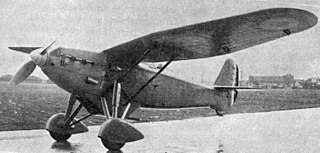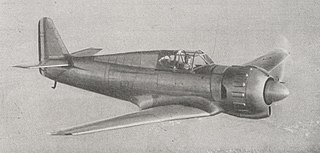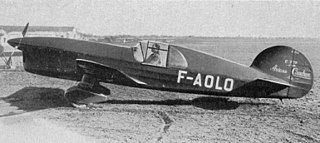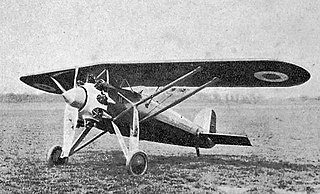 W
WThe ANF Les Mureaux 170 was a prototype French fighter aircraft of the 1930s. It was a single-engined, single-seat parasol monoplane, but only two were built, the type being rejected for service by the French Air Force.
 W
WThe ANF Les Mureaux 180 was a prototype French fighter aircraft of the 1930s. designed and built by Les Ateliers de Construction du Nord de la France et des Mureaux. It was a single-engined, two-seat, gull wing monoplane, only one was built and the programme was abandoned as obsolete.
 W
WThe ANF Les Mureaux 190 was a French prototype light fighter aircraft. In response to a program created by the French Minister of Air, the ANF Les Mureaux 190 was designed by André Brunet as a light fighter. The ANF Les Mureaux 190 was an all-metal monoplane, and was first tested in July 1936, then taken to the 15th Paris Air Show in late November, where it was asserted to be very manoeuvrable. However, less than a year later, the project was abandoned due to the poor quality of its engine.
 W
WThe Arsenal VG-33 was one of a series of fast French light fighter aircraft under development at the start of World War II, but which matured too late to see extensive service in the French Air Force during the Battle of France.
 W
WThe Bernard 70 was a 1920s design for a French single-seat monoplane fighter aircraft by the Société des Avions Bernard. It was not built but was developed into a racing monoplane designated the Bernard S-72,. It was further developed into single-seat fighters, the Bernard 74-01 and Bernard 74-02, although only two of the fighters were built.
 W
WThe Bernard H.52 was a French floatplane fighter aircraft of the 1930s. It was a single engine, single-seat monoplane built in the hope of being selected by the French Navy. Two prototypes were built, but no production followed.
 W
WThe Blériot SPAD S.510 was the last French biplane fighter to be produced.
 W
WThe Bloch MB.150 was a French low-wing monoplane fighter aircraft developed and produced by Société des Avions Marcel Bloch. It featured all-metal construction, complete with a retractable undercarriage and a fully enclosed cockpit.
 W
WThe C.710 were a series of light fighter aircraft developed by Caudron-Renault for the French Air Force just prior to the start of World War II. One version, the C.714, saw limited production, and were assigned to Polish pilots flying in France after the fall of Poland in 1939. A small number was also supplied to Finland.
 W
WThe Dewoitine 37 was the first of a family of 1930s French-built monoplane fighter aircraft.
 W
WThe Dewoitine D.500 was an all-metal, open-cockpit, fixed-undercarriage monoplane fighter aircraft designed and produced by French aircraft manufacturer Dewoitine.
 W
WThe Dewoitine D.513 was a 1930s prototype French monoplane fighter designed and built by Dewoitine.
 W
WThe Dewoitine D.520 was a French fighter aircraft that entered service in early 1940, shortly after the beginning of the Second World War.
 W
WThe Hanriot H.110 was an unusual pusher configuration, twin boom, single seat fighter aircraft built in France in the early 1930s. It proved to be slower and less manoeuvrable than its contemporaries and failed to reach production, even as the Hanriot H.115 after receiving a more powerful engine and cannon armament.
 W
WThe Loire 46 was a French single-seater fighter aircraft of the 1930s. A high-winged monoplane designed and built by Loire Aviation, it was purchased by the French Air Force. It was also supplied to the Spanish Republican forces during the Spanish Civil War, but was almost out of service by the outbreak of World War II.
 W
WThe Loire 210 was a French single-seat catapult-launched fighter seaplane designed and built by Loire Aviation for the French Navy.
 W
WThe Loire 250 was a French single-seat fighter monoplane designed and built by Loire Aviation of St. Nazaire.
 W
WThe Loire-Nieuport 161 was a single-seat, single-engine, all-metal, low-wing monoplane fighter designed and built in France in 1935 to compete for a government contract. Accidents delayed its development and only three prototypes were completed.
 W
WThe Morane-Saulnier M.S.225 was a French fighter aircraft of the 1930s. It was produced in limited quantities to be used as a transitional aircraft between the last of the biplanes and the first monoplane fighters.
 W
WThe Morane-Saulnier M.S.325 was a French Air Force fighter aircraft built by Morane-Saulnier in 1933 to meet the requirements of 1930 fighter aircraft specification. The design was unsuccessful and was abandoned in 1934.
 W
WThe Morane-Saulnier M.S.406 is a French fighter aircraft developed and manufactured by Morane-Saulnier starting in 1938. It was France's most numerous fighter during the Second World War and one of only two French designs to exceed 1,000 in number. At the beginning of the war, it was one of only two French-built aircraft capable of 400 km/h – the other being the Potez 630.
 W
WThe Morane-Saulnier MS.224 was a prototype fighter plane built by Morane-Saulnier in the early 1930s.
 W
WThe Nieuport-Delage NiD.62 was a French sesquiplane fighter from the early 1930s. This machine was a descendant of a long line of Nieuport-Delage fighters that were designed and built during the years immediately after World War I. The NiD.62 was built in 1931 as a fighter for the Armée de l'Air. It served until the late 1930s, when it was replaced by more modern monoplane fighters. By the time of the outbreak of World War II in September 1939, all of the NiD.62s had been withdrawn from front-line fighter escadrilles but were used as trainers in French flight schools. A few aircraft were employed as target tugs. After the French German Armistice and German occupation of North and West part of France in June 1940, the German Luftwaffe had no interest in the NiD.62s and they were scrapped. None survived the war.
 W
WThe Nieuport-Delage NiD 120 series was a series of French single-seat parasol monoplane fighter aircraft of the 1930s. It was built in a number of versions, fitted with various types of engines, with six aircraft designated NiD 123 being sold to Peru.
 W
WThe Potez 630 and its derivatives were a family of twin-engined aircraft developed for the French Air Force in the late 1930s. The design was a contemporary of the British Bristol Blenheim and the German Messerschmitt Bf 110.
 W
WThe Romano R.90 was a prototype single-seat French floatplane fighter of the 1930s. A single example of the R.90 was built, but the type did form the basis of the Romano R.83 and Romano R.92 fighters which were built in secret for the Spanish Republicans during the Spanish Civil War.
 W
WThe SNCAC NC-600 was a prototype French twin-engined long-range fighter aircraft, developed by SNCAC from the earlier Hanriot H.220 fighter. The type never entered service, with development being ended by the French surrender in June 1940.
 W
WThe SNCAO 200, sometimes written CAO.200, was a prototype French single seat fighter aircraft of the 1930s. It was a single engined monoplane intended to compete with the Dewoitine D.520, but was unsuccessful, only a single example being built.
 W
WThe SNCASE SE.100 was a French two-seat, twin-engined fighter which first flew in 1939. Mass production was planned to begin late in 1940 but the Fall of France prevented this.